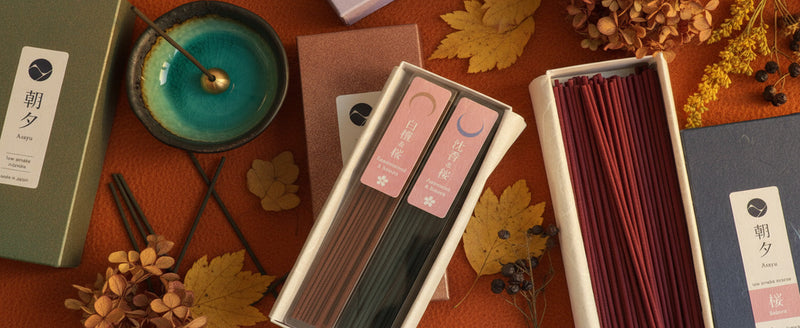
Is Japanese incense bad for you?

Is Japanese incense bad for you? Is incense smoke a risk for your lungs or general health? If you just started to dive in the world of incense, you surely have heard some people having concerns about the safety of burning incense and how can this impact your overall well-being. But is there any truth in those claims? What is the science behind it? Or is it just hear saying? Well, in this article we will address this important issue once and for all so you can have peace of mind!
What is incense made of?
When you want to enjoy incense you need 2 things: aromatic substances and a heat source. The aromatic substances, as the name indicate, contains the scent. And the heat source releases this scent.
The aromatic substances come from plant materials: woods, resins, seeds, roots, leaves, flowers... In Japan, the aroma is turned from the natural source into a powder typically bound together by a wood natural binder. The adhesive powder or binder, along with water, allow the powders of the raw materials to be formed into stick or other shapes. This is what makes different Japanese incense of Indian incense, since Indian incense uses a resin-based binder and has a bamboo stick as the center to keep it in shape. Also, these days it is common to find essential oils for more fragrance.
Take also into account that many incense today are not made from all natural ingredients. Those types of incense contain artificial fragrance and other chemicals, likely made form petro-chemicals.

How do you burn incense?
There are 2 main ways of burning incense. You can indirectly burn incense such as in Middle East, where small chips of oudh are burned over charcoal or embers. Or, as with Japanese incense, you can directly light up the incense stick.
Does incense smoke produce air pollutants?
When you burn anything, through the chemical process or combustion you create smoke and release gases and solvents into the air. There is no way around it. And, of course, it includes burning incense. However, if these chemicals are considered air pollutants or not depend on the chemicals present in the incense smoke when you burn it. Current research states that when there is a high concentration of carbon monoxide (CO), nitric oxide (NO) and sulfur dioxide (SO2) gases in incense smoke, it may affect your health if you regularly burn incense in indoor or close spaces with little ventilation.
So… is burning incense bad for you?
Then, how harmful is incense smoke? Is it worse than tobacco smoke? The truth is, as many scientific studies have shown, that inhaling a lot of any type of smoke in general for long and frequent periods of times is bad for your health. Period.
In this sense, there are a lot of studies talking about specific quantities and health risks of tobacco smoke, industry or factory smoke, etc. However, when it comes to incense there is no specific guideline or study that describes how much is “a lot” of incense smoke so this can be considered a risk or health hazard. But there is consensus in a set of best practices and moderate use to minimize the potential risks of incense smoke.

7 Things You Can Do to Safely Burn Incense
- Do not directly inhale or experience incense: When you burn incense, try to not expose your respiratory system directly to the smoke. If you do so, it can be as harmful as to smoking a cigarette. So always keep it at a safe distance away from your face!
- Increase your ventilation: Remember to always open your windows and doors to improve the airflow in the room in which you are burning incense.
- For people with asthma or respiratory conditions: If you or anyone in your house has any lung condition, don’t use incense in rooms everyone uses daily. Having a specific area that is used for incense burning is not only good for your self-care and mindfulness rituals, but it helps decrease exposure to air pollutants present in incense smoke.
- Stay away from strong perfumed incenses: We said it previously. Many current incenses are dipped into strong-smelling liquid. These means they included many synthetic ingredients to boost their aroma.
- Choose incense made from natural, plant-based ingredients: Without the addition of harmful chemicals, you can reduce the amount of air pollutants released in the smoke. Go always for incense with pure ingredients for a safer choice.
- Avoid burning resin incense with a wooden stick or on a charcoal: The smoke from the burning charcoal or the combination of resin and bamboo stick doubles the amount of smoke. This means it can produce additional harmful air pollutants such as carbon monoxide. Also, resins tend to be more irritant.
- Switch to low smoke incense: They do not produce that much smoke and are way less irritant.
Benefits of Japanese low smoke incense
We already know that the less smoke, the better. And since not two incenses are created equal, choosing Japanese low smoke incense is the best option for all who doubt if incense is bad for you.
As the name suggests, they lack the heavy smoke of other incense types. This makes them perfect for people sensitive to migraines, asthma or allergies. It is also a great point to consider if your place is narrow or the ventilation may be limited. And because of the use of pure ingredients, the fragrance is more natural and not overpowering at all. This also reduces the chances of dermatitis rashes. Plus, the subtle fragrance notes and soft aroma are the perfect complement for your health and all your meditation and self-care rituals!
And, if we may, shall we suggest you start your safe burning incense journey here at Asayu Japan? We offer a selection of 12 low smoke fragrances: 6 of them 100% natural and chemical fragrance free and other 6 of them with no added fragrance. They are also 100% Made in Awaji island, Japan, with ethically sourced and pure ingredients.
Now you are equipped with all the knowledge and facts to make an informed decision in your incense journey. We are very excited for you! But of course, if you still have any doubts about how to safely burn incense, let us know in the comments!
Asayu Japan Team


